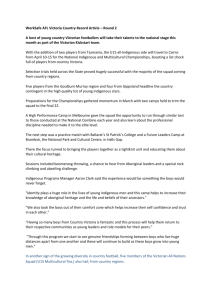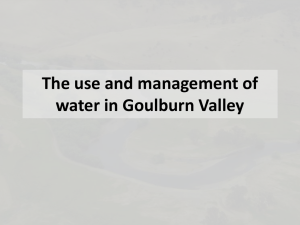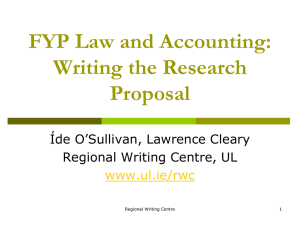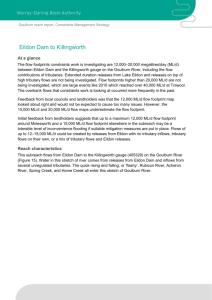Murray Goulburn Transport and Logistics
advertisement
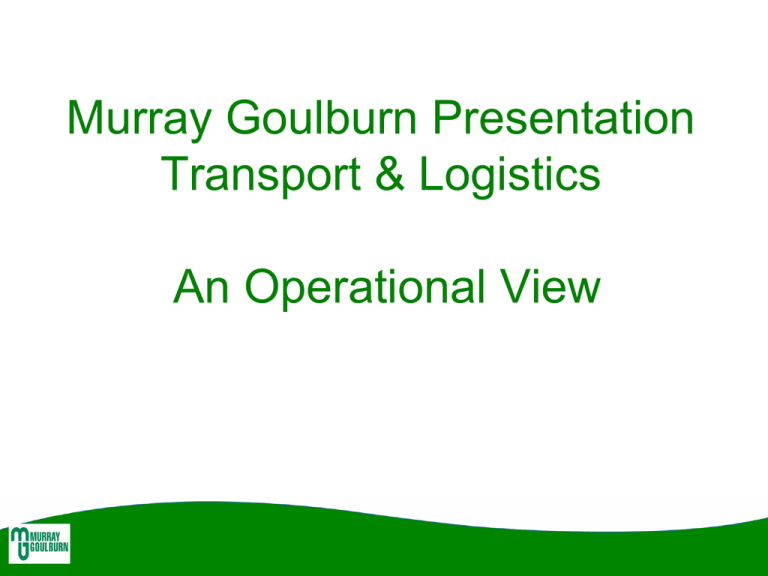
Murray Goulburn Presentation Transport & Logistics An Operational View Who Is Murray Goulburn Cooperative Co Ltd? • We are a 100% Australian farmer owned cooperative – “Aussie Farming Families” (Ref : MG Devondale advertisements circa 2010) • Established in 1950 in Cobram • 60 Years of Cooperative ownership with values that provide for farmers to benefit from downstream processing and provide maximum returns to the farmer. History • • • • Murray Goulburn has its origins in the soldier settlement region of northern Victoria. Returned serviceman, many of whom had never seen a farm, had become pioneer dairy farmers and were concerned that they were not getting the proper return for their efforts from local proprietary dairy companies. On 18 May 1949 the Murray Valley Soldier Settlers League called a meeting at Katunga to gauge public interest in the establishment of a new co-operative dairy factory. The support was unanimous and an interim committee was formed and empowered to find out all the necessary details required to establish a new dairy factory. And it was this committee that recommended Cobram as the site for the plant, mainly because the size of the town would make it easier to recruit workers and its proximity to the Murray River for water and red gum logs to fire the boiler. It was 20 February 1950 that the co-operative was registered as the Murray Valley Co-Operative Dairy Produce and Trading Company and the factory was opened at Cobram in May 1951. It was changed to Murray Goulburn following a number of mergers with other smaller factories in northern Victoria. Murray Goulburn Today • 3.1 billion lts of Milk produced in FY 2009/2010 (ref: Annual Report MG 2010) • 34.5% of Australia's total milk production is processed by Murray Goulburn (Australia’s total production est. 9.0 billion lts) (ref: Annual Report MG 2010) • Murray Goulburn owns in excess of 190,000 tonnes of Storage capacity in both dry and refrigerated goods over three (3) strategic sites • Two port side facilities (gateway to Melbourne's port precinct) and one 30 acre distribution/logistics centre in Laverton North • 170 company owned trucks, specialised bulk milk collection tankers, refrigerated trailers, high volume distribution trailers (dry freight) Murray Goulburn Today • 400+ transport staff, including drivers, support staff, in house maintenance teams & Management (not including distribution employees) • Total transport function from farm gate to end user (consumer) • Distribution networks including all major capital cities, export containers to over 100 countries in the world through our own and subcontractor network • 2009/2010 FY 25,000 containers exported through the Port of Melbourne, Australia’s largest dairy exporter and one of the largest users of the Melbourne port network Transport Task Murray Goulburn Transport is a complete supply chain network and provides service to all parts of the business. Transport has connections to every processing plant & distribution centre in the business • Farm To Factory – Milk off farm to processing plants • Local Distribution – Processing to Logistics centres • Freight forwarding to exports through ports • National Distribution – to major supermarkets and end users • Local transport – supply chain function – feeding consumables and products to processing plants • Local shipping ex Edith Creek (Tasmania) to mainland Transport Divisions • Farm to factory task is our major transport function with over 140 dedicated vehicles on the road for up to 24 hours a day 7days a week 52 weeks a year . • In the FY 2009/2010 the farm to factory fleet clocked up over 21 million kilometres collecting 3.1 billion lts of milk produced by 2400 dairy farming families through out Victoria, Southern New South Wales & South Australia. • Murray Goulburn have 7 manufacturing sites in regional areas throughout Victoria & Tasmania. Gippsland Transport • Gippsland milk production for FY 09/10 was 1.07 billion lts (equivalent to 34.5% of total MG milk intake) • Gippsland Fleet travelled 7.4 million kms in FY 09/10 • Gippsland fleet totalled 50 bulk milk collection tankers working up to 24 hours per day 7 days a week • 90% of time on road sees Gippsland fleet using local roads owned & maintained by local government (councils) • 80% of time on road is on unsealed or partially sealed roads and is claimed as “off road” use this includes private roads and access tracks on farm • Gippsland Transport employs almost 200 people in driving & non driving support roles The Challenges • As a major road user on local government roads we see and appreciate the need to have the road network maintained to a standard and the challenges that this provides. • We see that focus is required on the major freight route for goods both in and out of Sth Gippsland. • Improvements are always sought in the road network, the Sth Gippsland Hwy is one example of a road that has seen increases in traffic flow particularly in the past five years however the road has seen little in the way of improvement. • Secondary Links such as the Strezlecki Hwy linking Leongatha to the Latrobe Valley and East Gippsland are important and well frequented roads yet again have seen little or no infrastructure changes in the past five (5) years despite lobbying from various interest groups The Challenges • Although the population in and around South Gippsland & Greater Gippsland is low density the acknowledgement that through various channels the area is now for the most being acknowledged as a integral part of the food bowl for not only Victoria but also Australia and also the world through exports, not only Murray Goulburn. • If there is food that requires transport to cities and larger regional hubs for processing then a road network is required to meet the needs, We as a processor/transport company/ farm gate production need to have networks that will allow for the efficient and safe transport of goods with a view of doing this with a reduced impact on the environment & the communities we share the area with. How do we maximise our efficiency? • In our farm gate function (milk collection off farm) there is currently no substitute for road transport. • We then are looking for solutions that lessen the impact, Murray Goulburn have and continue to invest in vehicles and plant & equipment that provide efficient & safe practices. – road friendly suspensions are fitted to all tanker fleet (prime movers & Trailers) – Euro 5 engines have been provided in the latest purchases, – automated transmissions to improve driver comfort and increase fuel economy have been specced in recent purchases – LNG (Liquefied Natural gas) alternative fuel solutions have been fitted to existing fleet to improve emissions on pre Euro 3 engines – EBS/ESC – stability control systems have been fitted to applicable tanker fleet to again lessen the impact of the vehicle both on the road network and the driver LNG (Liquefied Natural Gas) • Murray Goulburn operates the largest LNG powered fleet on the Eastern Seaboard, currently 54 prime movers are operating on LNG in two key sites, Leongatha & Koroit • 3 models of engines currently operating using LNG technology Caterpillar C12 & C15 Clean Air Power along with Cummins ISX/ Westport • Testing conducted by the Australian government revealed 8% lower greenhouse emissions (Caterpillar C15)(Ref: Heavy Vehicle LNG trials Murray Goulburn/RARE Consulting 2008) LNG (Liquefied Natural Gas) • The option of the adoption of LNG by Murray Goulburn was based on the following criteria. – The only heavy vehicle fuel that appeared to provide comparable operation with diesel, while also offering potential economic and greenhouse benefits – Remains economic under the new federal fuel excise regime from 2011 – Adoption of dual-fuel technology allowed measured exposure to risk via diesel fall-back – Historically a price-stable fuel relative to diesel price volatility – A number of technologies supported by OEMs – An abundant energy resource that is indigenous to Australia (i.e. energy security) in the face of uncertainty about global oil resources (Ref: Heavy Vehicle LNG trials Murray Goulburn/RARE Consulting 2008) Computerised Scheduling of Milk Collection • Murray Goulburn have invested in technology that allows for the maximising of milk collection through computerised auto scheduling, this allows for trucks to be loaded effectively and efficiently using a range of data inputs including: – pick up windows of suppliers (farmers) – Farm access (B double access) – status of roads particularly with the added benefits of Mass Management – and also including time parameters to govern shift length (drivers hours) • This all comes together to provide the best overall service to our farmers – (customer service level) Higher volume combinations • Murray Goulburn pioneered the implementation of high volume combinations and were the first tanker operator in Victoria to use a “B” double for milk collection/distribution • B-DOUBLES: THE FIRST DECADE IN AUSTRALIA “B-doubles now carry more road freight than any other truck combination. Hard to believe but it is only 25 years since the first B-double was granted a permit in the Eastern States, the Murray Goulburn Bdouble. Just 24 months earlier, Western Australia had granted permits to two operators to carry shipping containers on B-doubles from Perth to Fremantle, the first B-doubles in Australia”. (ref:www.vta.com.au/publications) Higher volume combinations • Murray Goulburn Have continued building on this innovation and now run in excess of 46 “B” double combinations across its fleet. • This expansion has been able to be achieved through the commitment of Murray Goulburn Suppliers and local government to allow for the improvements sought through efficiencies with the allowance of higher volume vehicles on their road networks • Our suppliers see the advantages to high volume combinations as they are the owners of this fleet and as any fleet owner the seek to find ways of improving efficiencies and in doing so have invested on farm with opening up access for larger vehicles Mass Management • All Murray Goulburn Fleet are operating under the Mass Management accreditation throughout Victoria. • Currently the fleet involved in milk collection in Southern New South Wales does not enjoy the benefits of operating under Mass Management • We also have similar issues in South Australia collection • The benefits of operating under Mass Management allow for Murray Goulburn to have less vehicles on roads this reduces the risks associated with road transport and is a key component in our continuing ability to remain competitive in the transport & logistics field. Finished Goods Fleet • • • • • • Currently Operating eight (8) company owned purpose built high volume “B” double combinations transporting finished product from Leongatha to Murray Goulburn distribution centres in Melbourne These trucks have been purchased and are operated by the company to move the finished goods from the Leongatha site to various locations in the Murray Goulburn Logistics network. All fleet operate under Mass Management accreditation and again this is key to our ongoing involvement in this area. The fleet averages 33,000kms per week and carries on average the equivalent 4,350 pallets a week ex Leongatha Manufacturing sites This equates to our own fleet (excluding overflow contractors) travelling in excess of 1.52 million kms annually on Gippsland and inner metropolitan freight routes (Monash Fwy & Link roads) In the FY 2009/2010 – Leongatha Manufacturing plant produced 237,000 tonnes combined products Recent Events • Flooding in Northern Victoria and subsequent infrastructure damage. • Damage to Major Highways, Northern Hwy, Murray Valley Hwy, Kiewa Valley Hwy. • Bridges washed out causing additional kilometres to be travelled to accommodate for the damage incurred to major routes. • Tankers loaded accordingly and not a preferred maximum limits increased tanker activity to complete collection all adding to the cost of running our business although we are not alone in this MG Farming Families Devondale © The material contained in this presentation is the property of Murray Goulburn co operative Ltd. and should not be reproduced without the express permission of the author.
